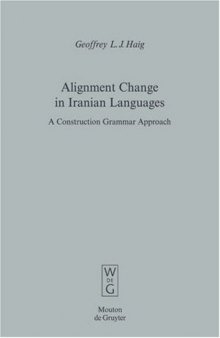دانلود کتاب Alignment Change in Iranian Languages: A Construction Grammar Approach
by Geoffrey L. J. Haig|
|
عنوان فارسی: تراز تغییر در زبان های ایرانی: رویکرد دستور ساخت و ساز |
 دانلود کتاب
دانلود کتاب
 جزییات کتاب
جزییات کتاب
نویسنده در این کتاب به بررسی نظام منسجمی پرداخته که در تحوّل زبانهای ایرانی وجود دارد. برای این منظور، وی نخست به معرّفی زبانهای ایرانی بر مبنای سه دورۀ ایرانی باستان، میانه و نو میپردازد. سپس با بررسی ویژگیهای واجی و نحوی زبانهای ایرانی که در متون فارسی باستان انجام میدهد، دیرینگی این نظام را از متون فارسی باستان پی میگیرد و وجود این نظام را منسوب به آن میدارد. نویسنده، نظریههای تازهای را در باب ارگتیو (ergative) در زبانهای ایرانی ارائه میکند و این امر به اهمّیت تحقیقات او در زمینۀ زبانهای ایرانی میافزاید. پس از این بررسی، به تجزیه و تحلیل تحوّلات فارسی میانه میپردازد. در این بررسی، توجّه مؤلّف بیشتر به زبانهای ایرانیِ میانۀ غربی و نقش ضمائر متّصل معطوف شده است. به نظر نگارنده، نقش این ضمائر در ایجاد نظام تحوّلات در همۀ زبانهای ایرانی، مشهود است. فصل چهارم این کتاب، به واکاوی مبحث نظام حالت (Case System) در زبانهای ایرانی پرداخته است. به باور وی، در این باره نوعی اصول یکسان و هماهنگ در شکلگیری این تحوّل به چشم میخورد. فصلهای پنجم و ششم به تفصیل به بررسی نظام حالت در زبان کردی میپردازد.
این تألیف یکی از آثار سودمند و در نوع خود تازه در زمینۀ شناخت تحوّلات زبانهای ایرانیست که هماهنگی این نظام را از دوران باستان تا میانه و نو در بر میگیرد. انجام این پژوهش، مانند آثار دیگر این زبانشناس برجسته حائز اهمّیت است و برای تحقیقات ایرانشناسی طلیعهای خوب به شمار میرود .








 این کتاب رو مطالعه کردید؟ نظر شما چیست؟
این کتاب رو مطالعه کردید؟ نظر شما چیست؟
